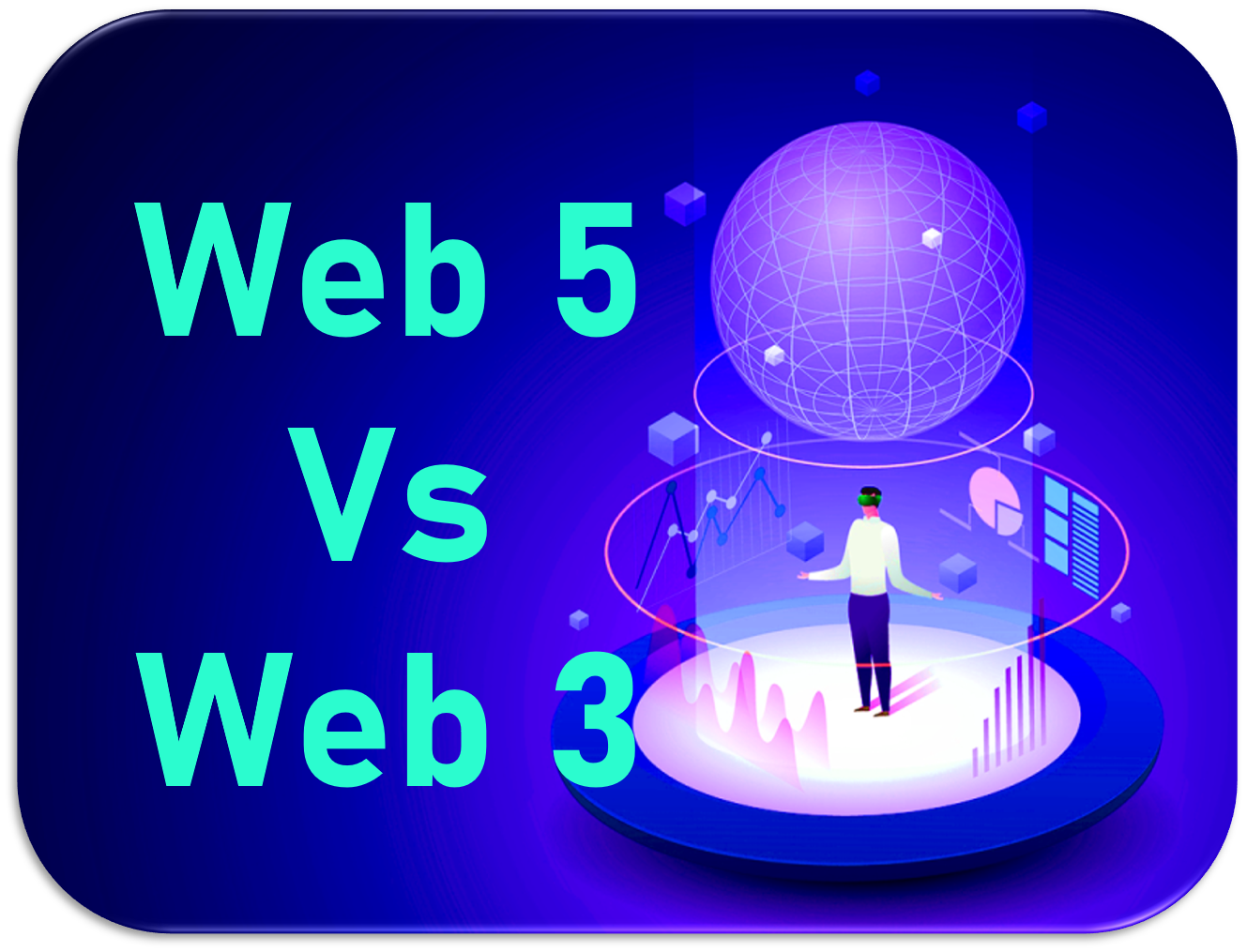Migrating Web Apps to Web3 vs. Web5: A Comprehensive Comparison
 Victor Oluwakayode Akintayo
Victor Oluwakayode Akintayo
Introduction
The digital realm constantly evolves, and at the forefront of this evolution stands Web5.0 - a transformative paradigm redefining decentralized web technologies. As we transcend the boundaries of Web3.0, Web5.0 emerges as more than a mere progression; it represents a seismic shift in the decentralized landscape, poised to revolutionize how we interact with digital applications.
Web5.0 isn't just another iteration; it's the game-changer, the catalyst driving us beyond the conventions of its predecessors. This paradigm, centered on user-centric decentralized data ownership, is redefining the very essence of digital interaction and control. From personalized Decentralized Web Nodes (DWNs) to unparalleled data autonomy, Web5.0 heralds a new era where users truly hold the reins of their digital lives.
This comprehensive guide navigates the intricate terrain of migrating from conventional web applications to the empowering realms of Web5.0. Join us on this exploration as we uncover the transformative power of Web5.0, a force reshaping the decentralized application landscape and placing the control of data firmly in the hands of its rightful owners – the users.
Key Takeaways
Web5.0 represents a paradigm shift in decentralized data ownership, prioritizing user control and empowerment.
Personalized Decentralized Web Nodes (DWNs) provide users with unparalleled control over their data.
Web5.0 offers distinct advantages over Web3.0, including user-friendly accessibility, simplified data migration, and seamless integration with wallets.
Embracing Web5: A Paradigm Shift in Decentralized Web Applications
The evolution of the internet has brought about transformative paradigms, notably the transition from centralized Web 2.0 to more decentralized approaches, culminating in the emergence of Web5.0. This innovative paradigm places user-centric decentralized data ownership at the forefront, redefining the way we interact with applications and manage our digital identities.
Migrating traditional web applications to the decentralized landscapes of Web3 and Web5 requires careful consideration and a deep understanding of the fundamental differences and practical implications of these migrations.
Migration Steps for Web3 Apps:
Define Objectives: Determine the aspects of your app that benefit from decentralization and blockchain integration.
Redesign Architecture: Integrate blockchain components like smart contracts, decentralized storage, and identity solutions.
Choose Tools and Frameworks: Select suitable development tools and frameworks supporting Web3 development (e.g., Solidity, Web3.js).
Implement Blockchain Integration: Integrate smart contracts into the app's backend and ensure security and functionality.
Enhance User Experience: Simplify complex blockchain interactions for users and provide clear instructions.
Test and Audit: Thoroughly test for functionality, security, and performance. Conduct audits for smart contracts and the system.
Community Engagement: Engage with the Web3 community to encourage adoption and participation.
Migration Steps for Web5 Apps:
Redesigning Data Storage: Instead of traditional databases, migrate app data storage to users' DWNs.
Writing to DWN: Utilize methods like
records.create()to write directly to users' DWNs.Establishing Protocols: Create and install protocols on users' DWNs to define data access and management.
Accessing Data: Reconfigure REST calls to use Web5.js for CRUD operations, querying data from DWNs.
The table below presents a comparison of migrating a Web app to Web5 as against Web3:
| Feature | Web3 | Web5 |
| Data Ownership | Decentralized ownership through blockchain | Personalized DWNs for direct data management |
| Technical Adaptation | Integration with blockchain components, smart contracts, and cryptographic principles | Redesign of data storage and modification of data access mechanisms for DWN interaction |
| User Interaction | Interaction through blockchain wallets requiring familiarity with crypto wallets and transactions | Simplified interaction leveraging wallet integration and decentralized data access |
| Complexity | Complexities in blockchain integration, smart contract development, and managing consensus mechanisms | Streamlined data migration to DWNs but might require adjustments to access patterns and data management |
| Developer Adoption | Proficiency in blockchain technologies and frameworks like Solidity, leading to a learning curve | Understanding of DWN management and adaptation of REST calls to Web5.js, focusing on data storage migration |
Web5 (Web5.0) and Web3 (Web3.0) represent different paradigms in the evolution of web applications, each with its own set of advantages and features. While both aim to decentralize and transform the web, Web5 emphasizes user-centric decentralized data storage and management. Here are some advantages of Web5 over Web3:
1. User-Centric Data Ownership:
Personalized Decentralized Web Nodes (DWNs): Web5 empowers users by providing them with their own DWNs, giving direct control over data storage and management.
Enhanced Privacy and Control: Users have complete ownership and control over their data, ensuring greater privacy and autonomy compared to traditional centralized models or even Web3's blockchain-based decentralization.
2. Simplified Accessibility:
Integration with Wallets: Web5 simplifies decentralized app accessibility by integrating with wallets. This makes the experience more user-friendly and accessible to the average end-user, reducing barriers to entry compared to complex blockchain interactions in Web3.
3. Streamlined Data Migration:
Migration to DWNs: Web5 enables a smoother transition from traditional databases to decentralized storage by migrating app data directly to users' DWNs. This migration process potentially reduces complexity compared to integrating various blockchain components in Web3.
4. User Experience and Interaction:
User-Friendly Interactions: Web5's focus on wallet integration and simplified data access allows for a more intuitive and seamless user experience. Users interact with their DWNs through familiar wallet interfaces, reducing the learning curve associated with blockchain wallets in Web3.
5. Reduced Dependency on Third Parties:
Direct User Control: Unlike Web3, which involves the use of blockchain networks and smart contracts, Web5 places emphasis on decentralization through personal data nodes, minimizing dependency on third-party providers or intermediaries.
6. Easier Development and Migration:
Data Management Simplification: While both Web3 and Web5 require adaptations for decentralized environments, Web5 may potentially simplify development by focusing on data migration to DWNs rather than complex blockchain integrations and consensus mechanisms inherent in Web3.
7. User Empowerment and Accessibility:
Data Accessibility: By providing users with direct access and control over their DWNs, Web5 empowers users to manage their data while making decentralized applications more accessible to average users, potentially increasing adoption rates.
8. User-Focused Paradigm:
User-Centric Design: Web5's emphasis on user-centric design aligns with modern user expectations regarding data ownership, privacy, and control, potentially appealing to users seeking more autonomy over their online interactions and data.
In summary, Web5's approach prioritizes user-centric decentralized data storage and management, potentially offering advantages in terms of user control, simplicity in data migration, enhanced accessibility, and a more user-friendly experience compared to the complex blockchain-based decentralization in Web3. The choice between Web5 and Web3 depends on the specific needs, goals, and preferences of the application and its user base.
Conclusion
While both Web3 and Web5 migrations emphasize decentralization and user empowerment, their approaches differ fundamentally. Web3 focuses on broader decentralization encompassing infrastructure and data, demanding significant architectural changes. In contrast, Web5 redefines data storage by directly empowering users through personal data stores without drastically altering the application logic.
The choice between Web3 and Web5 migrations depends on the level of decentralization desired, the complexity of data interactions, and the willingness of users to manage their data stores. Understanding the nuances between these migration approaches is pivotal for developers aiming to transition their applications into the decentralized web space.
Subscribe to my newsletter
Read articles from Victor Oluwakayode Akintayo directly inside your inbox. Subscribe to the newsletter, and don't miss out.
Written by
